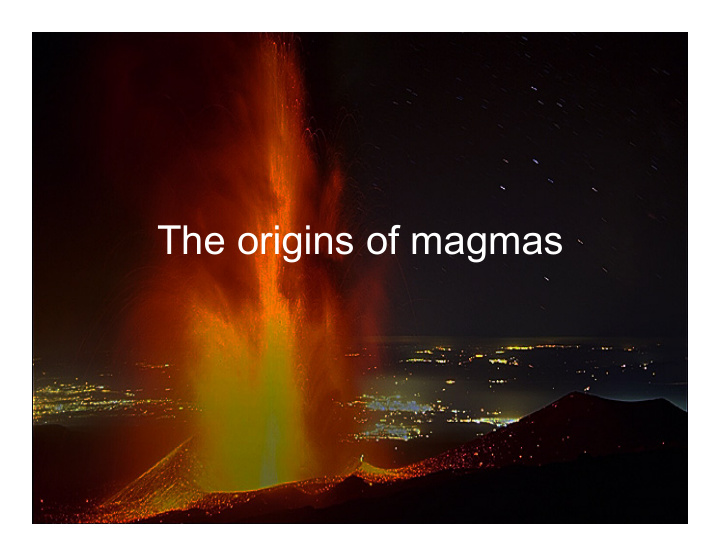



The origins of magmas
What is the primary magma? • Basalt
Origin of Basaltic Magma
Basalt in the world
Origin of basalt • What is basalt? • Where does it come from? • How do we know the Earth mantle? What state is it in? • Why does the mantle melt?
Definition of basalt
Where does it come from? • Melting in the upper mantle
How do we know the Earth’s mantle?
Sources of mantle material • Fragments of oceanic crust and upper mantle docked onto continents – Ophiolites • Dredge samples from oceanic fracture zones • Nodules and xenoliths in some basalts • Kimberlite xenoliths – Diamond-bearing pipes blasted up from the mantle carrying numerous xenoliths from depth
Plag Ultramafic Rocks: > 90% mafic minerals. “ mafic ” Ultramafic rocks have <10% plag. Mantle xenolith Olivine Dunite 90 The Peridotites Lherzolite 40 Orthopyroxenite The Pyroxenites Olivine Websterite 10 Websterite 10 Clinopyroxenite OPX CPX
Why does the mantle melt?
Heat Sources in the Earth 1. Heat from the early accretion and differentiation of the Earth still slowly reaching surface 2. Heat released by the radioactive breakdown of unstable nuclides
The Geothermal Gradient Figure 1-11(new) . Estimates of oceanic (blue curves) and continental shield (red curves) geotherms to a depth of 300 km. The thickness of mature (> 100Ma) oceanic lithosphere is hatched and that of continental shield lithosphere is yellow. Data from Green and Falloon ((1998), Green & Ringwood (1963), Jaupart and Mareschal (1999), McKenzie et al . (2005 and personal communication), Ringwood (1966), Rudnick and Nyblade (1999), Turcotte and Schubert (2002).
Phase diagram for aluminous 4-phase lherzolite: Al-phase = Plagioclase shallow (< 50 km) Spinel 50-80 km Garnet 80-400 km Si → VI coord. > 400 km Figure 10-2 Phase diagram of aluminous lherzolite with melting interval (gray), sub-solidus reactions, and geothermal gradient. After Wyllie, P. J. (1981). Geol. Rundsch. 70, 128-153.
How does the mantle melt?? 1) Increase the temperature http://images.google.com/imgres?imgurl=http://www.see.leeds.ac.uk/structure/dynamicearth/melt/melticon.jpg&imgrefurl=http://www.see.leeds.ac.uk/structure/dynamicearth/melt/ index.htm&h=255&w=400&sz=51&hl=en&start=2&um=1&tbnid=9BbC6vRDL3HszM:&tbnh=79&tbnw=124&prev=/images%3Fq%3Dmelting%2Bin%2Bthe%2Bcrust%26um%3D1%26hl%3Den %26client%3Dsafari%26rls%3Den%26sa%3DG
2) Lower the pressure – Adiabatic rise of mantle with little conductive heat loss – Decompression melting could melt at least 30% Figure 10-4. Melting by (adiabatic) pressure reduction. Melting begins when the adiabat crosses the solidus and traverses the shaded melting interval. Dashed lines represent approximate % melting.
Partial melting of mantle peridotite 1500 (TºC) 1100 1200 1300 1400 Melting begins when solidus upwelling mantle 10 intersects the peridotite Spinel lherzolite 20% solidus. With decreasing (Ol-opx-cpx-sp) 50 1% pressure above the Depth (km) 20 20% P (kbars) solidus, extent of melting 10% increases. The amount of Garnet lherzolite 1% melting is limited by the (Ol-opx-cpx-gar) 30 heat available since the 100 heat of fusion is large. Extent of melting can vary 40 from ~1% to ~20%. The T, Graphite P and % melting Diamond determine the composition 50 of the basaltic magma 150 produced 60
3) Add volatiles (especially H 2 O) Figure 10-4. Dry peridotite solidus compared to several experiments on H2O-saturated peridotites.
Melts in the mantle can be created under 2 main circumstances • Decompression melting = Adiabatic rise of the mantle – Divergent margins → Large upwelling (convection cells) – Hot spots → localized plumes of melt • Fluid fluxing = Addition of volatiles to the mantle – Subduction zones
Two styles of mantle melting
Schematic cross section through the upper part of the earth showing major magmatic environments 1. Mid-ocean ridge (divergent margin): thin crust, asthenosphere is close to earth ’ s surface, mantle upwelling, abundant basaltic volcanism/plutonism, e.g. Juan de Fuca Ridge, East Pacific Rise, Mid-Atlantic ridge 2. Intraplate volcanic/plutonic rift system, e.g. East African rift, Rio Grande rift 3. Island arc (convergent margin): built largely on oceanic crust—composed largely of island arc basalt and andesite 4. Continental arc (convergent margin): formation of new crust, volcanism/plutonism, mountain building, regional metamorphism 5. Back arc basin: basaltic volcanism—similar to MORB 6. Ocean islands: basaltic volcanism, e.g., Hawaii, Canaries, and many others 7. Scattered intracontinental activity: may be continental hotspots, e.g., Yellowstone
Recommend
More recommend